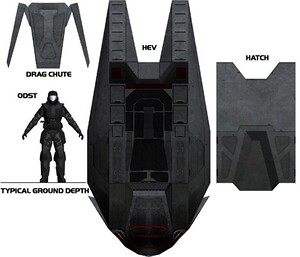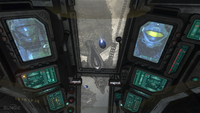Single Occupant Exoatmospheric Insertion Vehicle: Difference between revisions
From Halopedia, the Halo wiki
m (→Trivia) |
(→Trivia: The twenty minutes wasn't the fall to the surface, it was getting the ship within range for the drop.) |
||
| Line 96: | Line 96: | ||
== Trivia == | == Trivia == | ||
*In [[Halo 3: ODST]], the UNSC intended to use SOEIV pods to board [[Regret]]'s [[Assault Carrier]] before it jumped into [[Slipspace]] during the [[First Battle of Mombasa]]. Whether the pods were supposed to break through the Carrier and assault from within or land on top of it and enter it manually is unknown. | *In [[Halo 3: ODST]], it is revealed that the UNSC intended to use SOEIV pods to board [[Regret]]'s [[Assault Carrier]] before it jumped into [[Slipspace]] during the [[First Battle of Mombasa]]. Whether the pods were supposed to break through the Carrier and assault from within or land on top of it and enter it manually is unknown. | ||
*SOEIV's are featured prominently in ''[[Halo 3: ODST]]''. | *SOEIV's are featured prominently in ''[[Halo 3: ODST]]'', including a first-person experience of a combat drop. | ||
*In our present time, the United States Defense Advanced Research Projects Agency is currently working on [[wikipedia:SUSTAIN (military)|project SUSTAIN]], codenamed Hot Eagle. The basic thought is to have heavily armed [[United States Marine Corps|United States Marines]] launched into suborbital space and then reenter anywhere on earth in less then a total of four hours. Specifications have not yet been revealed to the public. | *In our present time, the United States Defense Advanced Research Projects Agency is currently working on [[wikipedia:SUSTAIN (military)|project SUSTAIN]], codenamed Hot Eagle. The basic thought is to have heavily armed [[United States Marine Corps|United States Marines]] launched into suborbital space and then reenter anywhere on earth in less then a total of four hours. Specifications have not yet been revealed to the public. | ||
*Popularly, the concept of dropping individual soldiers onto a planet from orbit in pods is attributed to [[Wikipedia:Robert A. Heinlein|Robert A. Heinlein]]'s novel ''[[Wikipedia:Starship Troopers|Starship Troopers]]''. HEVs in the Halo universe act similarly to those described in the book. ODST doctrine of 'command unit first' also resembles Mobile Infantry doctrine of 'officers first'. Additionally, the ODST tradition of playing the [[ODST]] Anthem prior to a drop is similar to Mobile Infantry traditions in Starship Troopers, with the anthem of the unit's respective troop ship played on their radios during mid drop. | *Popularly, the concept of dropping individual soldiers onto a planet from orbit in pods is attributed to [[Wikipedia:Robert A. Heinlein|Robert A. Heinlein]]'s novel ''[[Wikipedia:Starship Troopers|Starship Troopers]]''. HEVs in the Halo universe act similarly to those described in the book. ODST doctrine of 'command unit first' also resembles Mobile Infantry doctrine of 'officers first'. Additionally, the ODST tradition of playing the [[ODST]] Anthem prior to a drop is similar to Mobile Infantry traditions in Starship Troopers, with the anthem of the unit's respective troop ship played on their radios during mid drop. | ||
*In Halo Wars Captain Cutter's special ability allows you to drop | *In Halo Wars [[Captain Cutter]]'s special ability allows you to drop an entire squad of ODSTs in a single pod. This inconsistency shouldn't be regarded as canon, as it is undoubtedly applied to enhance gameplay, as the individual arrival of every single SOEIV would cause the feature to be much too slow for practical application. Also, the ability drops the ODST squad into battle much too quickly, with pods arriving on the surface seconds after the order is given. This, too, is acceptable as a gameplay conceit. | ||
*The shockingly high | *The shockingly high variety and rate of failures within SOEIVs can possibly be explained by simple financial problems. HEV's seem to be built to be disposable, therefore need to be built in large numbers, and therefore can't possibly be thoroughly checked for defects before being approved for service. | ||
*There | *There are a few modifications to the drop pods between ''Halo 2'' and ''3'' and their prominent feature in ''Halo 3: ODST'', such as two interior screens displaying the faces of squad leaders. | ||
==Gallery== | ==Gallery== | ||
Revision as of 04:02, September 28, 2009
A Single Occupant Exoatmospheric Insertion Vehicle,[1] also referred to as a Human Entry Vehicle or HEV, is a small pod used by the United Nations Space Command to deploy an individual from high orbit to the ground.
Operation
The SOEIV is an angular pod, approximately nine feet in length, a span of 8.5 feet and a height of 18 feet. Within it is a crash seat, communications gear, numerous equipment racks, and a rudimentary control system and a single entry and escape hatch. In spite of the size of the pod, there is not much room to move around, as the space given over to equipment storage lines the interior attached to the frame.[2]
Doctrine
In use for nearly three decades,[3] SOEIVs allowed for the rapid deployment of ground assault troops near or right onto an objective. Their smaller profiles made them more difficult to destroy by defensive fire than conventional dropships. Each pod bore the name of the soldier inside; amongst other things this identification could be used to identify the unfortunate occupant of a destroyed pod.
UNSC insertion protocols calls for the command unit of an SOEIV-facilitated assault to land first to minimize the period of disorder that might occur as pods landed and soldiers deployed. The reasons for this rule include the strongly held belief that officers should lead rather than follow, should be willing to do anything their troops are asked to do, and should expose themselves to the same level of danger as their subordinates. The commander’s pod is equipped with a lot of gear that the regular “eggs” are not, including high-powered imaging gear, tactical sensors, and a 4th generation, Class C Military "dumb" AI. SOEIV usage is popularly associated with the men of the elite Orbital Drop Shock Trooper divisions, although UNSC Special Forces operators and SPARTAN-II supersoldiers are known to use these as one of their primary infiltration methods as well [4][5].
Re-entry
The trooper enters the SOEIV and straps in facing the hatch. The hardened and shielded communications gear, which is built directly into the hatch, feeds the soldier information relevant to the current operation as well as providing a link between all members of the unit during the drop. While within the SOEIV a soldier's helmet integrated comm units are redundant and are normally only used if the pod's comm gear malfunctions.
A 30-second countdown begins on the commander’s mark, and the SOEIVs fire quickly down through the ship’s belly. The SOEIV is balanced to stabilize in a feet-down position. The pod has limited maneuvering capability, used primarily to coordinate landings, but may be used to avoid defensive anti-aircraft fire. However, if defensive anti-aircraft is present it is almost a mathematical certainty that some pods will be lost. A SOEIV is made of Titanium-A, Lead Foil, and a ceramic skin. The skin burns away during atmospheric reentry, protecting the rest of the pod and its occupant from the worst of the considerable heat. The Lead Foil is there to keep the Armor from ripping away and to replace the ceramic skin once it burns away. However, as the ceramic skin burns away the air inside the pods comes unbelievably hot,[6] and if the armored skin that covers a pod is damaged before or during its entry into atmosphere it has a tendency to fail spectacularly. And this is the reason for the SOEIV's small size — each hit only results in one death rather than the deaths of the entire unit.
After the SOEIV has penetrated the atmosphere, at an altitude of 3,000ft,[3] the upper exterior panels separate acting as a drag-type chute, slowing its descent some and keep the pod on course. At about 50 meters, the pod’s computer controlled breaking rockets engage, slowing the pod further; allowing for a safe though somewhat abrupt landing. Drag chutes on SOEIVs do fail on rare occasions, leaving the pod’s occupant to die on impact. It’s the death that every ODST fears, and is referred to in hushed tones as "digging your own grave."
HEVs are capable of smashing through almost any surface during re-entry, including buildings.[3] However, a reinforced roof should be able to withstand the impact, allowing an ODST to begin his mission with a distinct vertical advantage.[7]
Upon landing, each ODST is responsible for stripping their pod of its store of extra weapons, ammo, and other supplies, which are then hauled to the unit’s temporary base camp. ODSTs are used to operating without resupply for extended periods, and they are well known to be at their best when under difficult conditions.
Capacity
The vehicle contains weapons, ammunition, rations and a radio, and can be used as a shelter if need be.[3] It is also possible to store a light vehicle such as a M274 Ultra-Light All-Terrain Vehicle inside the SOEIV, or even a Shiva-class nuclear missile, although these have been referred to as "more bulky", suggesting a different variant.[8]
The SOEIV's also store an extra tank of rocket fuel, which is not used up in the landing, but is rather used for moving to a different location if the vehicle has somehow been knocked off target or is in a currently undesirable position. The pod, however, must be stood up in the position designed to land in.
Appearances
The HEVs makes it first appearance in Halo 2 and Halo 3. In Halo Wars, the HEV is one of the special abilities usable by Captain Cutter to drop down squads of ODST's into battle. However, the complete ODST upgrade is required in order to use this special power. The HEV does not make an appearance in Halo: Combat Evolved, but is mentioned in Halo: The Flood and has been mentioned through out the fiction. The HEV plays its most prominant role in Halo 3: ODST.
Other Versions
Long Range Stealth Orbital Insertion Pod
An improvement on the SOEIV was the Long Range Stealth Orbital Insertion Pod which came into service around 2545. The long range pods featured a Stealth Ablative Coating and could be launched from Slipspace. This pod was used to transport an entire battalion of SPARTAN III's to a covenant controlled planet in Operation TORPEDO in Ghosts of Onyx.
Covenant Orbital Insertion Pod
- Main article: Covenant Orbital Insertion Pod
The Covenant had an SOEIV equivalent known as a Orbital Insertion Pod. These were used to deploy Elites during the Battle of New Mombasa[9] and to aid Spartan-117 and the Arbiter during the Flood infestation in Voi. [10]. In one of the Halo 2 trailers, most of the Elites emerging from the OIPs were Special Operations. One of the main differences from their human counterparts is the ability to launch them over long distances away from their ship of origin, while HEV pods must be dropped directly underneath a ship.
Flood Dispersal Pod
Even the Flood parasite employs a similar method of troop-delivery, using a frame of Flood biomass or an encased SOEIV pod to encase single Combat Forms or a number of Flood Infection Forms for surface delivery in a similar manner. These were used by the Flood to reach the Installation 04 (II)[11] although how they were launched is still unknown. It is likely they just separate form the main hive and move at the same speed as the hive is moving.
Trivia
- In Halo 3: ODST, it is revealed that the UNSC intended to use SOEIV pods to board Regret's Assault Carrier before it jumped into Slipspace during the First Battle of Mombasa. Whether the pods were supposed to break through the Carrier and assault from within or land on top of it and enter it manually is unknown.
- SOEIV's are featured prominently in Halo 3: ODST, including a first-person experience of a combat drop.
- In our present time, the United States Defense Advanced Research Projects Agency is currently working on project SUSTAIN, codenamed Hot Eagle. The basic thought is to have heavily armed United States Marines launched into suborbital space and then reenter anywhere on earth in less then a total of four hours. Specifications have not yet been revealed to the public.
- Popularly, the concept of dropping individual soldiers onto a planet from orbit in pods is attributed to Robert A. Heinlein's novel Starship Troopers. HEVs in the Halo universe act similarly to those described in the book. ODST doctrine of 'command unit first' also resembles Mobile Infantry doctrine of 'officers first'. Additionally, the ODST tradition of playing the ODST Anthem prior to a drop is similar to Mobile Infantry traditions in Starship Troopers, with the anthem of the unit's respective troop ship played on their radios during mid drop.
- In Halo Wars Captain Cutter's special ability allows you to drop an entire squad of ODSTs in a single pod. This inconsistency shouldn't be regarded as canon, as it is undoubtedly applied to enhance gameplay, as the individual arrival of every single SOEIV would cause the feature to be much too slow for practical application. Also, the ability drops the ODST squad into battle much too quickly, with pods arriving on the surface seconds after the order is given. This, too, is acceptable as a gameplay conceit.
- The shockingly high variety and rate of failures within SOEIVs can possibly be explained by simple financial problems. HEV's seem to be built to be disposable, therefore need to be built in large numbers, and therefore can't possibly be thoroughly checked for defects before being approved for service.
- There are a few modifications to the drop pods between Halo 2 and 3 and their prominent feature in Halo 3: ODST, such as two interior screens displaying the faces of squad leaders.
Gallery
- 50105991-Full.jpg
External view of SOEIV launching tubes at the bottom of the UNSC Forward Unto Dawn.
- Halo3-ODST PodConcept-01.jpg
Concept Art from Halo 3:ODST of a variety of different SOEIV variants.
- Concept dropbay.png
SOEIVs inside a ship's drop bay.
Sources
- ^ http://www.bungie.net/projects/odst/guide.aspx
- ^ http://www.bungie.net/projects/odst/guide.aspx
- ^ a b c d Xbox 360 #35 pp34-37
- ^ Halo: Contact Harvest, page 350
- ^ Halo 2, level Delta Halo
- ^ Halo: The Flood, page 35
- ^ Halo: The Cole Protocol, page 132
- ^ Halo: The Cole Protocol, page 315
- ^ Outskirts (Level)
- ^ Halo 3, level Floodgate
- ^ Halo 3, level Halo


